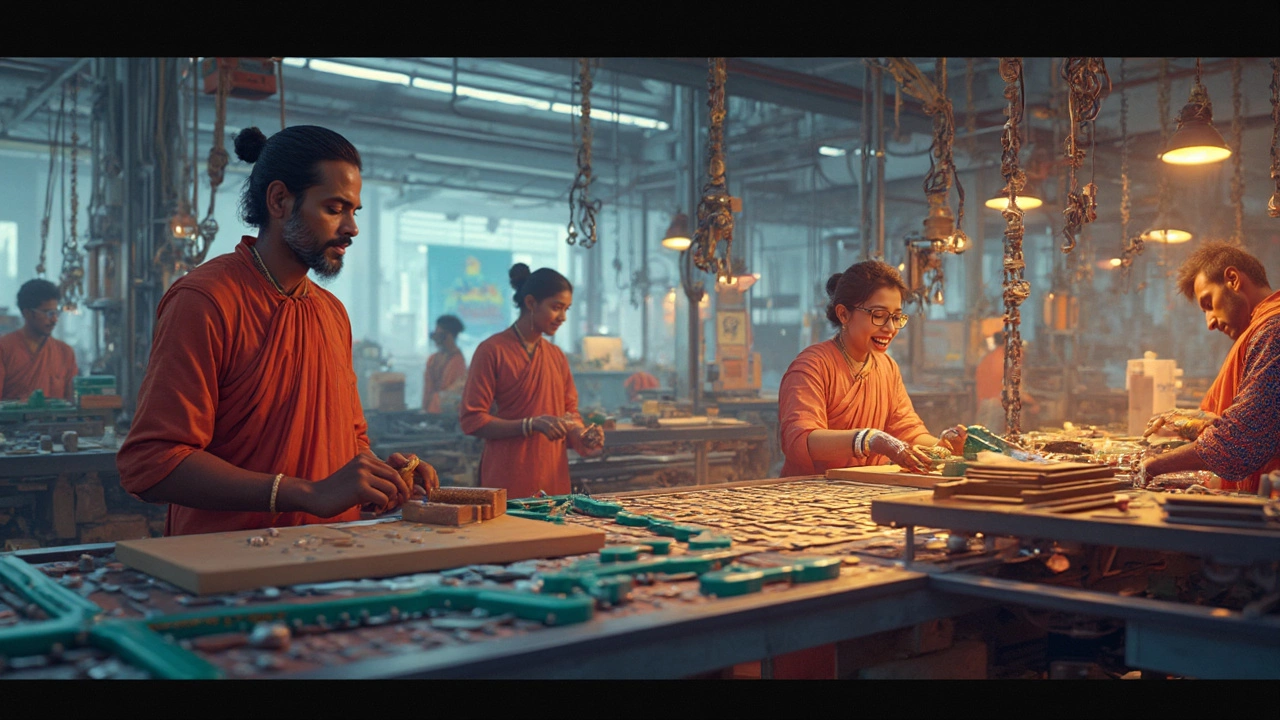Wondering which industries are going to make a splash in 2024? Well, you're in for a treat, especially if you're eyeing the manufacturing sector. With sustainability and technology leading the charge, there's a world of opportunity out there for those willing to adapt and innovate.
Sustainable manufacturing is making headlines for good reason. More and more companies are shifting to eco-friendly processes to reduce their carbon footprint, which means green manufacturing is no longer just a buzzword—it's becoming an industry standard. If you're thinking of diving into this field, consider how you can minimize waste and utilize renewable resources. It's not just good for the planet; it's becoming critical for staying competitive.
Then there's the technology wave. Automation, AI, and robotics are reshaping how products are made. This isn't about replacing jobs—it's about making operations more efficient and cost-effective. Businesses that adopt smart manufacturing technologies can streamline their production lines and respond more quickly to market changes. Exciting stuff, right?
- Rise of Sustainable Manufacturing
- Embracing Technological Advances
- Customized Products for Modern Consumers
- Healthcare Manufacturing Innovations
- Opportunities in Renewable Energy
- Smart Manufacturing and Automation
Rise of Sustainable Manufacturing
It's no secret that the world is shifting towards sustainability, and it's about time the manufacturing industry caught up. With climate change on everyone's radar, businesses are embracing green practices like never before. Sustainable manufacturing is all about creating processes that reduce environmental impact and conserve resources, which is fast becoming a priority.
Why? Well, consumers are more eco-conscious and prefer products that don’t harm the planet. Not to mention the regulations that are nudging companies towards more eco-friendly practices. It’s a win-win: good for the Earth, and potentially a great business move.
Steps Towards a Greener Tomorrow
If you're in the game, you're probably wondering how to jump on this eco-friendly bandwagon. Fortunately, there are some practical ways to make your manufacturing processes more sustainable:
- Renewable Energy: Switching to renewables like solar, wind, or hydroelectric power can significantly cut down on emissions.
- Waste Reduction Practices: Implementing recycling or repurposing processes helps to avoid waste while saving costs on materials.
- Energy Efficiency: Upgrading equipment to more energy-efficient models can drastically reduce power consumption.
Big Names Leading the Charge
Some companies are setting the standard, and they're worth mentioning. For instance, automotive giants like Tesla are known for their commitment to low-emission vehicles, and they've put sustainability right at the heart of their operations. Meanwhile, in the clothing industry, brands like Patagonia are pushing for recycled materials and environmentally friendly production methods.
What's in It for Business?
The benefits aren't just environmental. Cost savings, improved brand reputation, and new market opportunities are all on the table. Being a leader in sustainable manufacturing can differentiate your business in a crowded market.
Manufacturing execs, take note: a sustainable approach isn’t just a trend; it’s the future. Just remember, change won’t happen overnight, but small steps today can lead to major impact tomorrow.
Embracing Technological Advances
Technology isn't just enhancing the manufacturing scene—it's flipping it on its head. Think about the buzz around automation, AI, and robotics; they're more accessible than ever and a game-changer for any manufacturing business.
Let's talk about automation first. It's about making processes faster and reducing errors. Whether it's an automated assembly line or smart quality checks, businesses can boost production speed. A good example is the automotive industry, where advanced robotics have upped efficiency.
AI and Machine Learning
AI is another hot topic. Imagine having a system that predicts machine failures before they happen! That's the magic of predictive maintenance, saving companies thousands in repair costs and downtime. AI can also optimize supply chains by analyzing data trends.
The Rise of Robotics
Robots aren't just about replacing human jobs, but working alongside them. Collaborative robots, or 'cobots,' can handle repetitive tasks, allowing humans to focus on more complex work. This tech is revolutionizing sectors from electronics to healthcare manufacturing.
3D Printing
And keep an eye on 3D printing. It's not new, but it's getting cooler. Customizing and prototyping products faster cuts time and costs. Nike, for instance, uses it for rapid prototyping new designs.
Here's a quick look at how technology is impacting efficiency and cost:
| Technology | Efficiency Increase | Cost Reduction |
|---|---|---|
| Automation | 30% | 20% |
| AI | 25% | 15% |
| Robotics | 40% | 10% |
If you're running a business or planning to start one, adopting these technologies isn't just beneficial—it's becoming necessary. They offer a competitive edge, driving growth and innovation.
Customized Products for Modern Consumers
In today's world, consumers crave individuality and uniqueness, which means customized products are becoming a hot trend. Gone are the days when a one-size-fits-all approach worked. People want products that reflect their personality, and they’re willing to pay a premium for it.
Thanks to advancements in manufacturing and technology, it's easier than ever to offer tailored options. With technologies like 3D printing and digital design tools, businesses can create personalized items efficiently and at scale.
Meeting Consumer Demand
Consumers, nowadays, expect choices. Whether it’s selecting a color, adding a monogram, or even customizing the shape of a product, they want to feel involved in the creation process. This trend is not just limited to high-end goods; it’s translating into everyday products.
Technological Enablers
3D printing has revolutionized the ability to create customized goods. From jewelry to footwear, the ability to manufacture items on-demand reduces waste and keeps inventory costs down. Add digital design tools, and you can easily adjust designs to suit individual preferences.
For businesses in the manufacturing sector, this offers a golden opportunity. Providing customization can set you apart from competitors and tap into a market of consumers willing to pay more for personalized items.
Success Stories
- Nike allows customers to design their own sneakers, offering millions of combinations.
- Coca-Cola launched a campaign allowing people to personalize bottles with their names.
These examples underscore the potent potential of customization in driving sales and enhancing brand loyalty. Business ideas in this realm are boundless, and with tools and technology becoming more accessible, anyone can join the trend.

Healthcare Manufacturing Innovations
The healthcare industry is experiencing a massive transformation, driven by technology and the urgent need for effective solutions at scale. In 2024, we expect to see some exciting developments in manufacturing that could drastically change how healthcare is delivered.
Personalized Medical Devices
Imagine getting a medical device that’s tailored specifically for you. With advancements in 3D printing, customized healthcare products like implants and prosthetics can be produced with precision in a fraction of the time. This tech allows manufacturers to create devices that match the exact specifications of a patient, reducing the risk of complications and improving the success rates of surgeries.
Wearable Tech and IoT
Wearable technology is not just about smartwatches anymore. In the healthcare world, these products are saving lives by tracking vital signs and alerting users about potential health issues. Manufacturers integrating IoT (Internet of Things) capabilities into their products are opening up new avenues for diagnostics and real-time health monitoring. It’s a booming market that’s only going to get bigger.
Boosting Production with Automation
To meet the growing demand for medical supplies, automation is playing a key role in the healthcare manufacturing space. Robots and AI-driven machinery are enhancing production capacity, maintaining high quality, and ensuring fast delivery times. By streamlining operations, companies can focus on innovating instead of managing bottlenecks in their production lines.
| Innovation | Impact |
|---|---|
| 3D Printing | Custom, precise products |
| Wearable Tech | Improved health monitoring |
| Automation | Increased production efficiency |
The Green Transition
The push for sustainable manufacturing is also very much alive in healthcare. Manufacturers are now focusing on reducing waste and incorporating biodegradable materials to make the production process as environmentally friendly as possible.
In summary, if you're looking to enter the healthcare manufacturing industry or expand your current operations, keep an eye on these innovations. They're set to redefine the landscape and provide incredible opportunities to make a real difference in people's lives.
Opportunities in Renewable Energy
Dipping your toes into the renewable energy sector? It's not just the future—it's happening right now! As the world gets serious about fighting climate change, the renewable energy industry is booming. And there's plenty of room for manufacturers to jump in and make a splash. Let's talk about the big players: solar, wind, and even bioenergy.
Harnessing the Sun: Solar Manufacturing
Solar energy is the star of the show. With solar panel prices dropping and efficiencies rising, you can expect a surge in demand. Manufacturers specializing in solar panels or related components are in for a treat. Solar rooftops are on everything from homes to businesses, meaning there's a significant market for growth.
You might think, "Isn't the market saturated?" Not really. Regions like Africa and parts of Asia still have untapped potential. So, think global if you're getting into solar.
Winds of Change: Wind Energy
Next up, wind energy. The trends show that more wind turbines are popping up worldwide due to their efficiency and declining installation costs. If you're into manufacturing turbine blades or control systems, now's the time. Companies are also innovating with off-shore wind farms, expanding the geographical areas where wind energy can flourish.
Bioenergy: Turning Waste into Power
Maybe you've heard of bioenergy—turning organic waste into power. It's gaining steam, especially in agricultural sectors. By focusing on technologies that convert waste from farms or wood from mills into energy, you could be part of a sustainable future. It's about finding a niche and carving your space in the renewable energy market.
Quick Market Snapshot
| Energy Source | 2023 Market Share | Projected Growth by 2030 |
|---|---|---|
| Solar | 25% | 10% increase |
| Wind | 20% | 8% increase |
| Bioenergy | 10% | 5% increase |
If you're gearing up to kickstart your venture in manufacturing for the renewable sector, now is a brilliant time. Look for government incentives and partnerships with NGOs working to promote clean energy. It's not just about businesses; it's about making a cleaner, greener planet a reality.
Smart Manufacturing and Automation
So, what's the fuss about smart manufacturing? Simply put, it's where manufacturing meets internet-enabled technology for an ultra-efficient process. Thanks to advancements in AI, IoT, and robotics, the manufacturing floor is turning into a smoother, smarter place.
Manufacturing businesses today are investing in digital tools that make systems more adaptive and data-driven. Imagine being able to predict equipment failures before they halt your production line—this is called predictive maintenance, and it's a game-changer.
Key Benefits of Automation
- Efficiency: Automated systems can work 24/7 without fatigue, increasing output and reducing downtime.
- Cost Reduction: Cutting labor costs without sacrificing quality. Automated machinery requires less human oversight, saving on wages and training.
- Precision: Minimizing human error leads to higher quality products and fewer defects.
- Safety: By handling dangerous tasks, automation reduces accidents on the production floor.
And let’s not forget about data analysis. With automation, you're constantly collecting data. This helps you understand your processes better and spot areas for improvement. It’s like having a high-tech pulse on your production lines.
Industrial Robots
Robots have come a long way from being sci-fi fantasies. Now they're handling everything from assembly to logistics. In some sectors, robots have increased productivity by a whopping 150%! Not bad, right?
But how about the bottom line? It’s all about efficiency gains balanced with investment. Setting up these technologies isn't cheap, but the returns, both in time and quality, are often worth the upfront cost.
